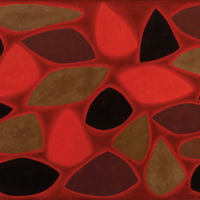77. JOHN COBURN

John Coburns monumental painting, Western Desert Dreaming, was created prior to a three-week expedition to northern and central Australia in July 1987, orchestrated by Vincent Serventy of the Australian Museum Society. Landing in Darwin, the group travelled to Kakadu and the sacred indigenous site of Nourlangie Rock famous for its ancient cave paintings before venturing to Cobourg Peninsula and the Gulf of Carpentaria. The trip ended in the continents symbolic heart, Uluru, where Coburn painted the changing colours of the rock at sunset.1
These experiences yielded a profound impact on Coburn, consolidating certain tendencies in his art that had first emerged in the mid-1960s. While Coburns earlier paintings often evoked natural forms that were vital and fleeting such as plants and birdlife he now sought inspiration from the earth itself.2 Coburns interest in this most fundamental of subjects was accompanied by a shift in cultural mindset - from the South of France to the Western Desert - as the influence of Matisse receded in favour of modern aboriginal art, in particular the Papunya painters. Coburns admiration for aboriginal art dated back to his years as a student at the East Sydney Technical College, when he became a regular visitor to the nearby Australian Museum.3 With its angular forms and rich, earthen palette, Coburns important early painting Legend I 1964 is in many ways an ode to aboriginal art.4
Western Desert Dreaming is surely one of the most ambitious and complex paintings within Coburns oeuvre. The viewer is immediately struck by its scale and immersive power. On a canvas spanning three metres in length, Coburn has arranged a cluster of terranean forms, held in perfect harmony. Colour, shape and tone are combined to form a deeply resonant image that recalls the most eternal elements of the landscape. In conversation with Nadine Amadio for her 1988 monograph, John Coburn described Western Desert Dreaming in detail:
I feel this painting is one that is most specifically related to the Australian land and desert and to Aboriginal art. Its about the earth and the land. In one sense its a landscape but in another sense its a pure abstract painting too. I think it works, too, because of its scale. If it were smaller it wouldnt have that same power. As the New York painters used to say when they did very big paintings, the bigger they were the more intimate they became. You are the painting. You can walk into the landscape.5
Footnotes:
1. Klepac, L., John Coburn: The Spirit of Colour, The Beagle Press, Sydney, 2003, p.78
2. Ibid., p.31
3. Ibid., p.80
4. Legend I 1964, oil on board, 122.0 x 140.0 cm, private collection; sold Shapiro Auctioneers, Sydney, 25 May 2021, lot 12, $180,000 (including buyers premium)
5. Amadio, N., John Coburn: Paintings, Craftsman House, Sydney, 1988, p.168
Catherine Baxendale